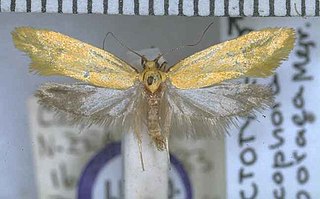
Cataclysta lemnata, the small china-mark, is a moth species of the family Crambidae. It is found in Europe, Morocco and Iran.

Parapoynx stratiotata, the ringed china-mark, is a moth of the family Crambidae. The species was first described by Carl Linnaeus in his 1758 10th edition of Systema Naturae. It is found in Europe where the distribution area extends in the north to the British Isles including Ireland and in the south to Sardinia, Sicily and Greece. The species is also found across the Palearctic in North Africa, Lebanon, Turkey, Azerbaijan, Kyrgyzstan, Uzbekistan and China..

Anania stachydalis is a species of moth of the family Crambidae. It is found in Europe. The species closely resembles Anania coronata.

Falcaria lacertinaria, the scalloped hook-tip, is a moth of the family Drepanidae. The species was first described by Carl Linnaeus in his 1758 10th edition of Systema Naturae It is found in Europe and Anatolia then east to Eastern Siberia.

Paranthrene dollii, commonly known as Doll's clearwing moth or the cottonwood clearwing borer, is a moth of the family Sesiidae. It is found in North America.

Syncopacma cinctella is a moth of the family Gelechiidae. It is found in all of Europe, Asia Minor and North Africa. In the east, the range extends through Siberia to the Russian Far East.

Epinotia nisella is a moth of the family Tortricidae which is found in the Palearctic, Europe and North America. It was first described by Carl Alexander Clerck in 1759.

Grapholita jungiella is a moth of the family Tortricidae. It is found in most of Europe, east to the Near East and the eastern part of the Palearctic realm.

Apotomis betuletana is a moth of the family Tortricidae. It is found in most of Europe. It is also found in the eastern part of the Palearctic realm.

Cryptaspasma querula is a moth of the family Tortricidae. It is endemic to New Zealand and can be found throughout the country. This species inhabits podocarp and broadleaf forest. The larvae consume parts of the seeds and fruits of tawa, tarairi and miro trees and are predated upon by the invasive to New Zealand house mouse. Adults are variable in appearance and also in size. They are on the wing throughout the year and are nocturnal but are attracted to light. They can be found having flown inside houses and have also been observed resting on fences or other human made structures during the day.

Coptotriche marginea is a moth of the family Tischeriidae, found in most of Europe. It was named by the English botanist, carcinologist and entomologist, Adrian Hardy Haworth in 1828, from a specimen found in England. The larvae mine the leaves of brambles (Rubus) species.

Syncopacma taeniolella is a moth of the family Gelechiidae. It is found in most of Europe.

Phaulernis fulviguttella, the yellow-spotted lance-wing, is a moth of the family Epermeniidae found in the Palearctic including Europe.

Ichneutica steropastis, or the flax notcher moth, is a species of moth in the family Noctuidae. It is endemic to New Zealand and can be found throughout the country from the Three Kings Islands to Stewart Island as well as in the Chatham Islands. The larvae of this species feed on a variety of native and introduced plants however the New Zealand flax is one of the more well known host plants for the larvae of this moth. The larvae are nocturnal, hiding away in the base of the plants and coming out to feed at night. They create a distinctive notch in the leaf when they feed. The adults of this species are on the wing from October to March. Although adult specimens of I. steropastis are relatively easy to recognise they might possibly be confused with I. inscripta, I. theobroma or with darker forms of I. arotis. However I. steropastis can be distinguished as it has a long dark basal forewing streak that these three species lack.
Hypatima rhicnota is a moth in the family Gelechiidae. It was described by Edward Meyrick in 1916. It is found in southern India.
Mnesistega talantodes is a moth in the family Gelechiidae. It was described by Edward Meyrick in 1918. It is found in southern India.

Eulamprotes unicolorella, the unmarked neb, is a moth of the family Gelechiidae. It was described by Philogène Auguste Joseph Duponchel in 1843. It is found in almost all of Europe. The habitat consists of wastelands and dry open areas.

Tingena macarella is a species of moth in the family Oecophoridae. It is endemic to New Zealand and is found on both the North and South Islands. Adults of this species are on the wing from November until February. This species is attracted to light and the larvae are litter feeders.

Tingena oporaea is a species of moth in the family Oecophoridae. It is endemic to New Zealand and has been observed in Canterbury. The perferred habitat of this species is native beech forest at altitudes of 2500 ft however it has also been collected in tussock grassland. The larvae of this species are leaf litter feeders and the adults are on the wing in January and February.

Thylacosceles acridomima, also known as the pūniu spore-eater or the micro-featherfoot, is a moth of the family Stathmopodidae. This species is endemic to New Zealand. It was first described by Edward Meyrick in 1889.




















